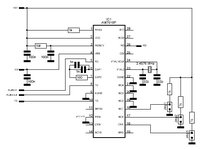neazoi
Advanced Member level 6
Hi I have configured an AM7910 modem IC to use only bell103 and bell202 modes without back channel, no handshaking. I ignore all the other settings/modes of the chip. Here is the rough schematic attached.
My questions are in the page 7 and 11 of the datasheet.
1. If set for Bell103 answer mode and no TX data is sent across, does a default mark tone of 2225Hz continuously present on the TC pin if RTS is grounded?
2. If set for Bell202 and no TX data is sent across, does a default tone of 2025Hz present on the TC pin if RTS is grounded?
3. When I change the state of RTS/ will these default tones deactivate? (TX off)
4. If I want to change modes from bell103 originate, to bell103 answer and vice versa, I could follow the 4-steps process on page 7, DTR/pin description. However, can I switch off the modem, configure MC0/MC1 and then switch it back on, or do I need to also manipulate the DTR pin accordingly?
Thanks a lot
My questions are in the page 7 and 11 of the datasheet.
1. If set for Bell103 answer mode and no TX data is sent across, does a default mark tone of 2225Hz continuously present on the TC pin if RTS is grounded?
2. If set for Bell202 and no TX data is sent across, does a default tone of 2025Hz present on the TC pin if RTS is grounded?
3. When I change the state of RTS/ will these default tones deactivate? (TX off)
4. If I want to change modes from bell103 originate, to bell103 answer and vice versa, I could follow the 4-steps process on page 7, DTR/pin description. However, can I switch off the modem, configure MC0/MC1 and then switch it back on, or do I need to also manipulate the DTR pin accordingly?
Thanks a lot
Attachments
Last edited:
